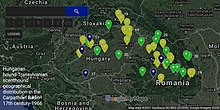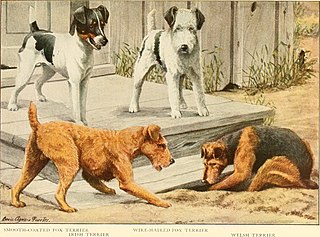
Terrier is a type of dog originally bred to hunt vermin. A terrier is a dog of any one of many breeds or landraces of the terrier type, which are typically small, wiry, game, and fearless. There are five different groups of terrier, with each group having different shapes and sizes.

Scent hounds are a type of hound that primarily hunts by scent rather than sight. These breeds are hunting dogs and are generally regarded as having some of the most sensitive noses among dogs. Scent hounds specialize in following scent or smells. Most of them tend to have long, drooping ears and large nasal cavities to enhance smell sensitivity. They need to have relatively high endurance to be able to keep track of scent over long distances and rough terrain. It is believed that they were first bred by the Celts by crossbreeding mastiff-type dogs with sighthounds. The first established scent hounds were St. Hubert Hounds bred by monks in Belgium during the Middle Ages.

The Serbian Tricolour Hound is a breed of scent hound from Serbia.

Griffon is a type of dog, a collection of breeds that were originally hunting dogs. There are three lines of the griffon type recognized by the Fédération Cynologique Internationale (FCI): the Griffon Vendéens, the wirehaired pointers, and the smousje. The griffon type is characterized by rough- or wire-hair.

The Grand Basset Griffon Vendéen or GBGV is a dog breed from France.

The Hamiltonstövare is a breed of scenthound originally developed by the founder of the Swedish Kennel Club, Count Adolf Hamilton. Its ancestors include several German hounds as well as English Foxhounds and Harriers. The breed is recognized by the Swedish Kennel Club, Federation Cynologique Internationale (FCI) and the American Kennel Club's Foundational Stock Service.

The Petit Basset Griffon Vendéen, or PBGV, is a breed of dog of the scent hound type, bred to trail hares in bramble-filled terrain of the Vendée district of France. The breed is known in the United States as "Petit" or "PBGV," in England as "Roughie," and in Denmark as "Griffon" or "Petit". The PBGV is one of six types of "basset"-type breeds recognised by the Fédération Cynologique Internationale (FCI).

Smaland Hound is a breed of dog that originated in Sweden in the 16th century. Thought to be the oldest scent hound breed native to Sweden, it was first recognized by the Swedish Kennel Club in 1921. They are the smallest of the Swedish hound breeds, and have black and tan markings similar to the rottweiler. Internationally, it is recognized by a number of kennel clubs and registries including the Fédération Cynologique Internationale and United Kennel Club. It is considered rare, even in its native Sweden where only around sixty puppies are registered each year.

The Segugio Italiano is either of two Italian breeds of dog of scent hound type, the wire-haired Segugio Italiano a Pelo Forte or the short-haired Segugio Italiano a Pelo Raso. Apart from the coat type, they are closely similar, and in some sources may be treated as a single breed; the Fédération Cynologique Internationale and the Ente Nazionale della Cinofilia Italiana treat them as separate. They are also genetically close to the other two Italian scent hound breeds, the Segugio Maremmano and the Segugio dell'Appennino. They are traditionally used for hunting hare, but may also be used in boar hunts.

The Basset Bleu de Gascogne, also known as the Blue Gascony Basset, is a long-backed, short legged breed of dog of the hound type. A French native breed, it is rare outside its homeland. It is recognized internationally by the Fédération Cynologique Internationale, in the UK by The Kennel Club, and by the United Kennel Club in the United States. The "bleu" of its name is a reference to its coat which has a ticked appearance.
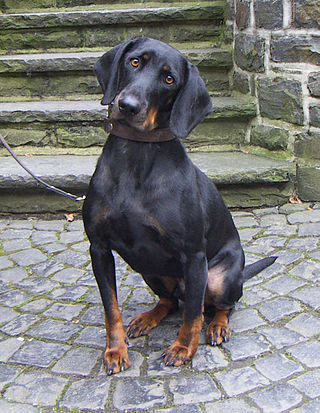
The Austrian Black and Tan Hound is a medium sized scenthound originating in Austria and is used for tracking wounded game, most commonly hare, in high altitudes.

The Barak or Bosnian Broken-haired Hound, is a hunting dog breed developed in Bosnia. The breed is a scenthound, originally used to hunt large game. Other names include Bosnian Rough-haired Hound and Bosnian Rough-coated Hound. These names refer to the texture of the shaggy coat, usually called broken-haired or hard in English dog fancier jargon.
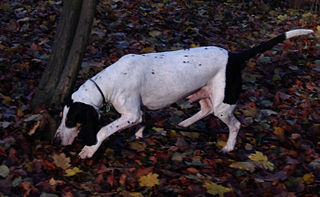
The Ariégeois is a French breed of medium-sized scent hound from the département of Ariège in the Midi-Pyrenées region of southern France. It may have derived from cross-breeding of pack-hunting hounds such as the Grand Bleu de Gascogne or Grand Gascon-Saintongeois with local Briquet dogs. It hunts either alone or in a pack, and is used both as a courser and for driving game to waiting guns. While most successful with hares, it is also used for hunting deer and boar. It does not adapt well to urban life, and is not usually kept as a companion dog.

The Drever is a breed of dog, a short-legged scenthound from Sweden used for hunting deer and other game. The Drever is descended from the Westphalian Dachsbracke, a type of German hound called Bracke. The breed name Drever was chosen through a contest in 1947.

The Hungarian Wirehaired Vizsla is a Hungarian breed of pointer dog. The Hungarian name, Drótszőrű magyar vizsla, is translated as Hungarian Wirehaired Pointer.

The Westphalian Dachsbracke is a small, short-legged scenthound, a breed of dog originating in Westphalia, a region of Germany. The Westphalian Dachsbracke was used in Sweden to develop the Drever.

The Slovenský kopov is a medium-sized breed of hunting dog of the scenthound type. The breed originated in Slovakia, in Central Europe, and is bred for deer tracking and boar hunting. The name Black Forest Hound seems to have been created in North America for marketing purposes, since the breed has no connection with the Black Forest. The German name for this breed is Schwarzwildbracke which translates to Wild Boar Hound and not Schwarzwaldbracke which would be Black Forest Hound.

The Grand Anglo-Français Blanc et Noir translated into English as the Great Anglo-French White and Black Hound, is a breed of dog used in hunting as a scenthound, usually in packs. It is one of the Anglo-French hound breeds which were created by crossing French scenthounds with English (Anglo) Foxhounds.
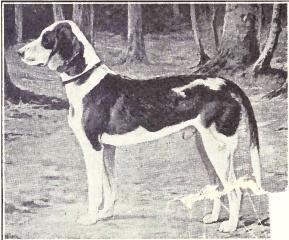
The German Hound is a breed of dog originating in Westphalia, a region of Germany. The German Hound is of the scenthound type, used for hunting both large and small game.



